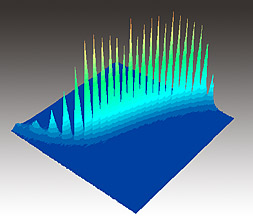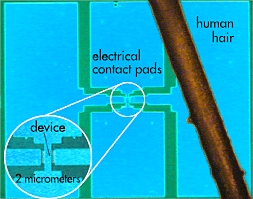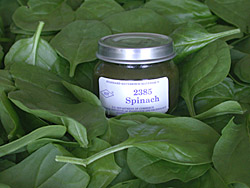Cell
Phone Still Too Big? Micro-Oscillators May Help
 |
| A
three-dimensional plot shows how the microwave frequency
(x axis) generated by a new NIST oscillator varies
with changes in the current (y axis). The height of
each peak represents the power of the signal produced
at specific frequencies. |
| |
 |
A
tiny, novel device for generating tunable microwave signals
has been developed by researchers at the National Institute
of Standards and Technology (NIST). Described in the Jan. 16
issue of Physical Review Letters, the device measures
just a few micro-meters square and is hundreds of times smaller
than typical microwave signal generators in use today in cell
phones, wireless Internet devices, radar systems and other applications.
The device works
by exploiting the fact that individual electrons in an electric
current behave like minuscule magnets,
each
one with a “spin” that is either up or down, just
as an ordinary magnet has a north and a south pole.
The NIST
device consists of two magnetic films separated by a non-magnetic
layer of copper. As an electric current passes
through the first magnetic film, the electrons in the current
align their spins to match the magnetic orientation in the
film. But when the now aligned electrons flow through the
second magnetic film, the process is reversed. This time the
alignment
of the electrons is transferred to the film. The result is
that the magnetization of the film rapidly switches direction,
or oscillates, generating a microwave signal. The microwave
signal can be tuned from less than 5 gigahertz (5 billion
oscillations a second) to greater than 40 GHz.
The NIST experiments confirm predictions made by theorists
at IBM Corp. and Carnegie Mellon University in 1996.
NIST physicist
William Rippard says the new oscillators can be built into
integrated circuits with the same technologies now used to
make computer chips and that they may eventually replace bulkier
technologies at a greatly
reduced cost.
Media
Contact:
Fred McGehan,
(303) 497-3246


Advice
for Designing Reliable Nanomaterials
Stronger
or tougher? For designers of advanced materials, this tradeoff
may complicate efforts
to devise efficient methods for assembling nanometer-scale
building blocks into exotic ceramics, glasses
and other types of customized materials.
“Not all properties may benefit from microstructural refinement,
so due caution needs to be exercised in materials design,” writes
the National Institute of Standards and Technology’s
(NIST) Brian Lawn in the January issue of Journal of Materials
Research.* An expert on brittle materials, Lawn advises that
past experience is not always a useful guide for predicting
material properties and performance when film thicknesses,
grain sizes and other characteristic dimensions shrink toward
molecular proportions. At this level, materials designers
must reckon with interatomic force laws that are obscured
at larger
scales, from micrometers (millionths of a meter) on up.
“Generally
in brittle materials, strength (resistance to crack initiation)
increases and toughness (resistance to crack
propagation) decreases as characteristic scaling dimensions diminish,” Lawn
concludes from his work to refine ceramics used in biomechanical
applications such as dental crowns and orthopedic implants.
At the nanoscale, tiny cracks require more load to spread
them, but have little resistance to extension once they
start and
are, therefore, more likely to spread catastrophically.
Depending on the application in mind, the decrease in fracture toughness
may more than offset initial gains in strength, or the
ability to withstand stresses that squeeze, stretch or twist the
material.
This
poses challenges for designers who choose to build minuscule
devices and tiny systems with ceramics because
of the light
weight, high strength and hardness. Lawn says contact
points in devices with moving parts will require especially
close
attention. As the size of contacts decreases, he notes,
stresses will become more concentrated, “increasing
the potential for irreversible damage and premature failure
at ever-lower
critical loads.”
Media
Contact:
Mark Bello, (301) 975-3776
*B.R.
Lawn, “Fracture and Deformation in Brittle Solids:
A Perspective on the Issue of Scale,” J.
Mater. Res., Vol. 19, No. 1,
Jan. 2004.


New
Standard on the Menu, Certified Slurried Spinach
Popeye
was right: spinach is good for you. The National Institute
of Standards and Technology (NIST) now has certified exactly
what’s in it.
Standard
Reference Material (SRM) 2385 consists of small jars of slurried
spinach—pure spinach
that’s been blanched,
pureed and passed through filter screens. The concentrations
of vitamins and other constituents have been measured and certified,
so that the food industry can use the SRM to validate analytical
methods and provide accurate nutritional information for its
products. An analytical method is evaluated by using it to
measure constituents in the SRM and then comparing the
results to the
NIST-certified values.
 |
Slurried
Spinach 2385, a new NIST Standard Reference Material, can
be used by food manufacturers to help ensure the accuracy
of nutritional labels. |
The
NIST values confirm that spinach is rich in antioxidants—both
beta-carotene and lutein. Although the actual amounts look
small (the antioxidants constitute 0.0019 percent and
0.0033 percent
of the spinach by mass, respectively), spinach contains far
more of the two combined than most other fruits or
vegetables.
Antioxidants
help fight formation of free radicals, highly reactive
molecules that can damage DNA and are implicated in the development
of certain diseases. Beta-carotene converts
to vitamin A in the body and is needed for healthy vision,
skin and hair. Lutein is a pigment found in the retina
and
may help
guard against eye diseases such as age-related macular
degeneration. Among its other attributes, spinach also contains
1.55 percent
dietary fiber by weight.
The
new SRM was developed at the request of the food industry
and with the help of more than
10 food manufacturers. NIST
now supplies 37 different food SRMs to the industry, one
or more
for each of the nine sectors of the Association of Analytical
Communities’ food triangle, which categorizes food
based on its fat, carbohydrate or protein content. The food
triangle
helps to assure the availability of validated analytical
methods for all types of foods.
Media
Contact:
Laura
Ost, (301) 975-4034


Online
Calculator Improves Analysis of Chemical Data
National
Institute of Standards and Technology (NIST) scientists
recently unveiled an online calculator on NIST’s
Web site designed to make chemical analysis by mass spectrometry
faster and more reliable. The tool also may make some chemical
evidence introduced in criminal cases more trustworthy.
The
NIST tool, called MassSpectator, automates the mathematical
calculations needed to convert plots of mass spectrometry data
into final results—a listing of the chemical components
and concentrations of substances in a mixture of unknown composition.
Mass spectrometry works by measuring the mass of single molecules
within a chemical compound. It does this by first turning solid
or liquid substances into charged particles called ions. The
ions then are manipulated with magnetic fields, radio frequencies
or other means so that molecules with different masses hit a
detector at different times and/or locations. Signals from the
detector are plotted as “peaks” that represent molecules
of different sizes.
The
NIST software automatically, without any user involvement,
identifies and calculates the
size of the peaks. Previously
available software requires user interaction to take that
second step.
By
automating the entire calculation process, MassSpectator
saves time; makes it much easier to work
with massive datasets
such as those used to study the functions of proteins;
and eliminates errors or bias that might be introduced
by manually
translating mass spectrometry peaks into final chemical
results. For example, by using Mass Spectator’s
automated calculations, law enforcement agencies can
increase confidence
in chemical
analyses conducted during criminal investigations.
For
further information, see www.nist.gov/maldi.
Media Contact:
Scott Nance, (301) 975-5226


Quick
Links
New
Values for Fundamental Constants—Accurate values
for fundamental physical constants—like the speed of
light in a vacuum, the mass of an electron, or Avogadro’s
constant—are required in many practical calculations
made in scientific and technical work. New values for more
than 300 basic constants and conversion factors are now available.
These values, recommended by the international Committee on
Data for Science and Technology (CODATA), are the result of
an adjustment carried out by NIST physicists under the auspices
of the CODATA Task Group on Fundamental Constants. For more
information, see http://physics.nist.gov/constants.
Learn
from the Best— Organizations large or small;
in service, manufacturing, education or health care; with one
office or multiple sites around
the globe—all can benefit from the knowledge and experience
of the seven recipients of the 2003 Malcolm Baldrige National
Quality Award.
The Quest for Excellence XVI conference will be the first
opportunity to learn about the exceptional practices and
results of the
2003 recipients: Medrad, Inc. (manufacturing); Boeing Aerospace
Support (service); Caterpillar Financial Services Corporation
U.S.
(service); Stoner, Inc. (small business); Community Consolidated
School District 15 (education); Baptist Hospital, Inc. (health
care); and Saint Luke’s Hospital of Kansas City (health
care). The conference will be held March
28-31, 2004, in Washington, D.C. For further information,
call
(301) 975-2036 or visit the Baldrige National Quality Program
Web site at http://baldrige.nist.gov/Quest_for_Excellence.htm.
Baldrige Criteria for 2004 Available—In
addition to being the basis for a Baldrige Award application,
Baldrige Performance Excellence Criteria are used by
thousands of organizations to assess and improve their performance
in a wide range of areas, including leadership, corporate
governance
and ethics, employee and customer relations, and results.
The 2004 Baldrige criteria for business, education and
health
care
are now available. The criteria may be downloaded from
http://baldrige.nist.gov or
may be requested by calling (301) 975-2036.
Submitting 2004 Baldrige Applications Electronically—For
the first time, organizations can electronically submit their
applications for the Malcolm Baldrige National Quality Award.
In prior years, applicants submitted 25 copies of their application
for review by the award’s private-sector board of examiners.
Organizations can submit their application on a CD in PDF format
by May 13. The 2004 Baldrige Award application forms booklet is
available at http://baldrige.nist.gov/Award_Application.htm
or by calling (301) 975-2036.

